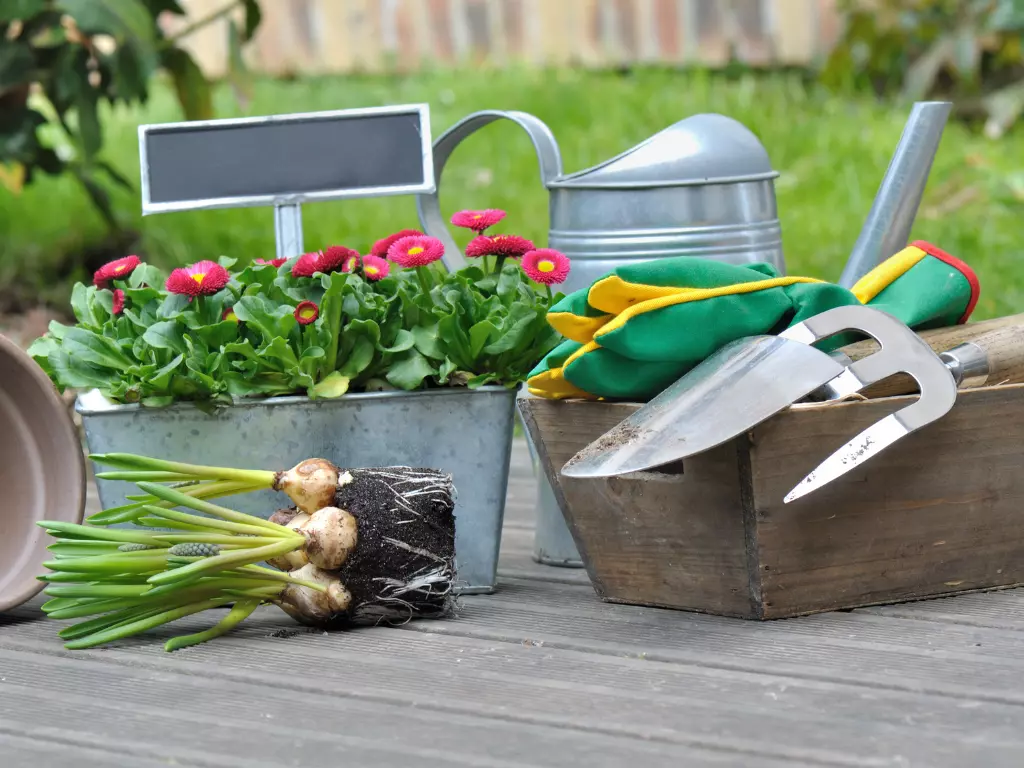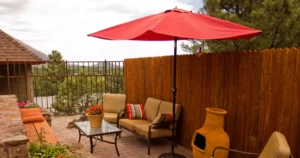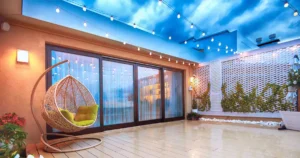You know, when I was thinking about sprucing up my little patio, planting some greenery really seemed like the way to go. Nothing transforms an outdoor space quite like adding a bit of nature, turning it from just another concrete slab into somewhere you’ll actually want to spend time. Plants have a way of making even the smallest area feel warm and welcoming. So that’s what got me wanting to learn more about how to decorate patio with plants and see if I could turn it into a little oasis of my own.
Doesn’t matter if you just have a tiny patio in the city or a big deck in the suburbs – when figuring out how to decorate your patio with plants, a few potted greeneries can totally change the whole vibe out there.
Plants add such nice pops of color and interesting textures. Can you imagine how boring that concrete patio would be without anything green growing on it? But throw in some flowers, succulents, and maybe a little hanging ivy – it all comes to life!
And the best part is plants really don’t take that much work. Sure, Yeah, they’ll need a drink every once in a while, but it’s not like you have to commit your whole day to gardening or anything. Most of the time it’s just a quick water and call it good.
So, if you want to cozy up your patio without a ton of effort, just read on. I’ll fill you in on everything you need to know to get your outdoor space planted upright. From picking the best plants to arranging them – it’s all here to help you create your own little natural oasis.
Why Decorate Your Patio with Plants?

You know, the more I think about it, there are a ton of awesome reasons to get some plants out on your patio. It just makes so much sense to decorate with a little greenery. I mean where do I even start?!
Adds Privacy
Nothing says “stay out” quite like some tall plants blocking the view, am I right? Put some bamboo or little trees around the edges and it really helps you feel secluded, even if you’re right in the middle of the city. Perfect if you don’t want neighbors staring in too.
Attracts Cool Critters
Bring on the butterflies and hummingbirds! Putting out some nice flowers is sure to draw them in so they can get a drink. Plus, you’ll see all kinds of songbirds in the trees if you pick plants with berries or whatever. How fun is it to watch all that buzz around while you’re relaxing?
Improves the Air
Houseplants and flowers? They purify as they beautify. Pulling in all the nasty stuff we breathe in the city and releasing that good oxygen. When you’re outside it’s great to fill your lungs with the cleanest possible.
Adds Color & Interest
Talk about variety – flowers come in every hue under the sun! And leaves come in all kinds of textures and shades of green too. Switching it up keeps things looking fresh.
Provides Season-Long Fun
Ever seen tulips in spring and mums in fall? Pick plants with different blooming times and your patio’s always in show. Color all year, how cool!
Serves as Eye-Catchers
Going for a “wow” factor? Put a big statement plant front and center and it draws everyone’s gaze right in. Anchors the whole space.
Softens it All Up
That stone or concrete is way cozier with some plant life mixed in, don’t you think? Brings nature indoors, or rather outdoors I s’ pose!
Choosing the Right Plants
When you’re picking out plants for your patio, one of the most important things is choosing varieties that will actually do well in your space. You have to match them to your patio’s specific situation, you know?
Climate
Consider your hardiness zone and average seasonal temperatures. Choose plants that can withstand the coldest and hottest conditions. Be aware of microclimates that may exist if your patio is sheltered.
Sunlight
Note the number of hours of sunlight and shade on each area of the patio. Select plants suited to the specific light levels of each spot. Most edible and flowering plants need at least 6 hours of direct sun.
Soil
Pay attention to the type of soil or potting mix already available in planted beds or containers on the patio. Pick plants with preferences that match.
Water
Be realistic about how often and how much you will water containers. Prioritize drought-tolerant plants like succulents if watering frequency is limited.
Size at Maturity
Imagine how large each type of plant will eventually grow, both in height and width. This ensures they won’t outgrow the space.
Maintenance Level
Opt for low-maintenance plants like succulents if upkeep needs to be minimal. Avoid plants prone to pest and disease issues.
Best Plants for Decorating Patios

Alright, when it comes to actually picking out some plants, here are a few that I think are total winners for patios:
Flowering Annuals
- Petunias – Cascading and upright varieties available. Withstand heat.
- Geraniums – Bold colors. Tolerate drought.
- Marigolds – Cheerful flowers. Repel insects.
- Zinnias – Vibrant colors. Attract butterflies.
Ornamental Grasses
- Pennisetum – Graceful, fountaining foliage. Red or purple plumes.
- Carex – Attractive bronze or gray wispy blades. Grow in the shade.
- Muhlenbergia – Delicate pink flowers. Tolerates heat and drought.
Succulents
- Hens and Chicks – Rosette shapes. Thrive in full sun.
- Jade Plant – Thick woody stems. Easy to propagate.
- Aloe Vera – Unique spiky leaves. Soothes sunburned skin.
Edible Plants
- Tomatoes – Trellis or cage climbing varieties. Need 6+ hours of sun.
- Herbs – Thyme, rosemary, oregano. Withstand drought when established.
- Chili peppers – Liven things up with bright colors. Prefer a warm, sunny patio location.
Tropical Plants
- Mandevilla vine – Showy pink flowers. Climbs up trellises.
- Banana trees – Enormous decorative leaves. Grow fast in warm climates.
- Elephant ears – Giant bright green and purple leaves. Give bold texture.
Shrubs and Small Trees
- Japanese maple – graceful foliage and fall color. Provides dappled shade.
- Hydrangeas – Large colorful blooms. Some newer varieties tolerate the sun.
- Hibiscus – Tropical appeal with big, bright flowers. Hardy in warm zones.
For specific garden care guides visit Dave’s Garden.
Design Principles for Decorating with Plants
Follow these basic design concepts as you place plants on your patio:
Focal Points
Use striking plants in bold containers to create focal points, drawing attention to specific areas. Place at ends of sightlines.
Variety in Height
Incorporate plants of varying heights – tall, medium, and low. This adds visual interest and depth.
Grouping
Cluster 3-5 pots of the same plant together in a pyramid or staggered formation for impact.
Repetition
Repeat colors, textures, and plant varieties in different areas to tie the space together.
Contrast
Combine leafy and spiky, mounding, and trailing plants. Pair tall vertical grasses with spreading groundcovers.
Negative Space
Allow open areas or negative space between plants and pots. This prevents a crowded, cluttered look.
Symmetry and Balance
Strive for visual symmetry and an even distribution of plant material across the space.
Top 10 Patio Plant Décor Ideas
- Create a lush container garden with various flowering annuals and foliage. Mix colors, shapes, and sizes.
- Line the edges with bamboo, grasses, or tall narrow trees for privacy and vertical interest.
- Make an edible patio with tomatoes, herbs, fruit trees, and vegetable plants. Use smart pots to grow food in small spaces.
- Accent with succulents. Group colorful rosettes and trailing varieties in unusual containers like concrete bowls and galvanized buckets.
- Use climbing vines like jasmine, grape ivy, and passionflower to cover walls, trellises, pergolas, and railings.
- Add drama with ornamental grasses. Use mollies, pampas grass, and striped varieties in large containers.
- Create a relaxing oasis with water features like fountains and birdbaths surrounded by palms, ferns, and shade-loving begonias.
- Make bold statements by layering different sizes of similar-looking plants together, like a mass of spiky yuccas.
- Use hanging baskets and vertical wall planters on balcony and terrace railings to grow cascading petunias, fuchsias, and million bells.
- Light up the patio at night with lighting and white and pastel flowers that reflect and glow.
Maintain Your Patio Plants for Long-Lasting Beauty

While installation requires effort, regular maintenance keeps your patio plants thriving and beautiful for seasons of enjoyment. Develop a routine to optimize performance.
Watering
Check soil moisture daily, watering thoroughly when the top inch is dry. Adjust based on heat/humidity – succulents may need water just once weekly while tropical prefer daily during heatwaves. Water at the soil level, not foliage to reduce disease/rot.
Consider a drip irrigation system for efficiency. Raise containers off hard surfaces so water drains beneath rather than pooling.
Fertilizing
Feed container plants monthly during active growth with balanced, water-soluble plant food. In-ground plants can go 3 months between applications of slow-release granular fertilizer in spring/summer to encourage robustness.
Pruning and Deadheading
Remove faded blooms from annuals like petunias regularly to maintain flowering. This encourages new growth. Prune back woody plants after flowering season. Shear herbaceous perennials down in late winter before new growth begins.
Division and Replanting
Crowded clump-forming perennials like daylilies become stagnant and stop flowering after a few years. Dig, divide roots, and replant portions in early spring or fall to revitalize. Refresh container plantings annually with fresh soil.
Dealing with Pests
Check regularly for signs of insects, diseases, or viruses, addressing issues promptly before they spread. Natural and organic remedies usually suffice for patio beds. Always identify problems accurately before treatment.
Winter Preparations
Reduce watering but don’t allow soils to fully dry out as nights cool. Move containers under eaves before first frost or store blooming annuals in a cold frame over winter. Cut back deciduous perennials after leaf drop. Mulch tropical and succulents.
Decorating Your Patio with Plants – Final Thoughts

You know, putting some plants out on your patio is such a simple way to totally upgrade your outdoor space. Suddenly it goes from being just a slab of concrete to a little oasis filled with nature.
When you choose the right plants for your space, pairing what will actually thrive based on sunlight, water needs, etc. it sets everything up for success.
Then have some fun arranging them in unique ways. Mix up heights, play with different leaf textures, and try combining colorful flowers. Place your showstopper plants front and center too.
Be sure to sprinkle in herbs and blooms to attract butterflies. Who doesn’t love watching all the wildlife buzz around while you relax outside?
As long as you keep the plants happy with a little TLC-like watering, your patio will stay looking its best all season.
I hope this comprehensive guide on “How to Decorate Your Patio with Plants” has provided all the expert information and inspiration needed for your successful project! Don’t be afraid to get creative either – your backyard is waiting for its moment in the spotlight. Have fun decorating your own special plant-filled sanctuary.
Frequently Asked Questions (FAQs)
Q: What types of plants work best on a patio?
Some good patio plant options include succulents, herbs, ferns, ivy, petunias, etc. Choose plants that match your light conditions and care needs.
Q: How do I know which plants will thrive in my patio conditions?
Consider the sunlight, soil type, temperature, and water drainage when selecting plants. Match your patio’s microclimate to plant hardiness zones and water requirements.
Q: What is the best way to arrange plants on my patio?
Group plants by height, color, and texture for visual interest. Use statement plants in large pots as focal points. Consider trailing vines on walls or structures too.
Q: How often do patio plants need to be watered?
Watering needs vary by plant. Check soil moisture daily and water when the top inch is dry. Succulents may only need once a week while tropical often need daily water.
Q: Should I use fertilizer on my patio plants?
Most plants benefit from fertilizing monthly during the growing season. Use a balanced, water-soluble plant food or compost to promote healthy growth.
Q: How can I protect plants from extremes in temperature?
Provide shade for plants on very hot days. Bring containers inside if temperatures will drop below freezing. Consider hardier, cold-tolerant varieties for winter patios.
Q: What can I do about pests on my patio plants?
Identify the pest (insects, disease, weeds) and treat accordingly using natural or organic remedies if possible. Remove infected plant parts and isolate affected plants.







